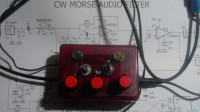Morse CW audio radio telegraph filter

With this simple selective peak filter, you can significantly improve the signal/noise ratio when listening to CW Morse transmissions on an AM/SSB shortwave radio with a standard 200Hz-3000Hz audio speech span output.
During this Covid crisis, I set up some SW antennas, for emergency communications in case of a possible internet/telephone/GSM network breakdown. I have a nice SW radio, Tecsun PL-600 (http://www.tecsun-radios.com/product/tecsun-pl600-ssb-radio/) , but like many other radios it offers only standard 200Hz-3000Hz audio speech range output.
Since CW signals need much less bandwidth, the signal/noise ratio can be further improved with a selective narrow band filter. This simple circuit does this job. It can also separate several CW signals of different audio frequencies, that can sometimes be received simultaneously within 3000Hz span.
Peak frequency is set using P3, S1 and S2, in the range 200Hz-2000Hz. I use stereo headphones, SW radio audio output connected straight to right headphone, and filtered output to left headphone.
1.) Set P1 to low selectivity
2.) Tweak S1,S2 and P3 to get some signal in the left headphone
3.) Increase selectivity with P1, while compensating the amplification with P2. You are OK when yellow LED1 flashes in sync with audible dashes and dots.
A circuit around IC2B is a Schmitt trigger - it outputs a simple squarewave mark/space. Possible remaining fast spikes (<10ms) are removed with IC3. Its output can be used by an MCU for automatic decoding.
This way, the -3dB frequency span can be reduced to only 15Hz. This is 200x less than 3000Hz, which means that noise can be reduced by the factor of x14 (-23 dB).
Since CW signals need much less bandwidth, the signal/noise ratio can be further improved with a selective narrow band filter. This simple circuit does this job. It can also separate several CW signals of different audio frequencies, that can sometimes be received simultaneously within 3000Hz span.
Peak frequency is set using P3, S1 and S2, in the range 200Hz-2000Hz. I use stereo headphones, SW radio audio output connected straight to right headphone, and filtered output to left headphone.
1.) Set P1 to low selectivity
2.) Tweak S1,S2 and P3 to get some signal in the left headphone
3.) Increase selectivity with P1, while compensating the amplification with P2. You are OK when yellow LED1 flashes in sync with audible dashes and dots.
A circuit around IC2B is a Schmitt trigger - it outputs a simple squarewave mark/space. Possible remaining fast spikes (<10ms) are removed with IC3. Its output can be used by an MCU for automatic decoding.
This way, the -3dB frequency span can be reduced to only 15Hz. This is 200x less than 3000Hz, which means that noise can be reduced by the factor of x14 (-23 dB).



Mises à jour de l'auteur